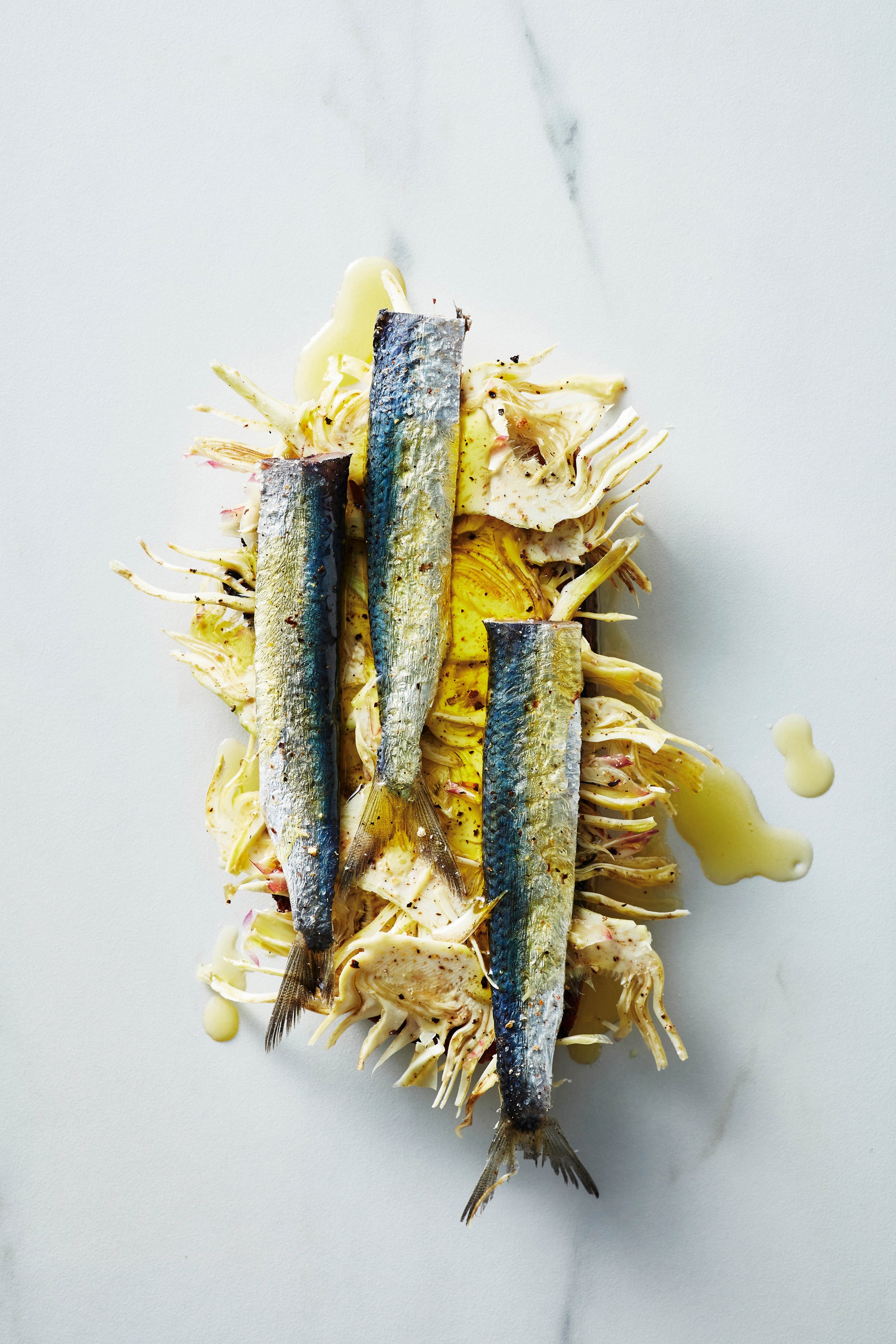‘A dish that requires patience’: Josh Niland’s salted sardine fillets recipe
Salted sardine fillets and globe artichokes make for a tasty open sandwich, writes Ella Walker

The secret to this dish is to not compromise on the quality of produce – from the sardines to the bread and olive oil, right down to the salt you use to cure the sardines, everything needs to be as good as it can be. It’s also a dish that requires patience. Yes, you could have something similar by pulling the ring back on a tin, but where is the fun in that?” says chef Josh Niland.
“Once you’ve gone to the trouble of making them, you’ll be rewarded with your very own salted sardine fillets, which can essentially be used like salted anchovies in a huge range of dishes. Like pure umami, they’ll add magic to pasta, compound butters, mayonnaise, salads and more, but be sure to save the brine from the salting process as well, as this will serve as an excellent seasoning for other dishes. If artichokes aren’t in season or unavailable, then grilled capsicums (bell peppers) and marjoram make a wonderful substitute, as do semi-dried tomatoes and lovage. This recipe is also excellent with store-bought salted sardines, anchovies and even tuna for those who want it right now!”
Salted sardine fillets and globe artichokes on grilled bread from Take One Fish by Josh Niland
Serves: 2 (with leftover sardines)
Ingredients:
1kg (2lb oz) fresh whole sardines
2kg (4lb 6oz) best-quality rock salt
Chilled water, for soaking about 500 ml (17fl oz or 2 cups)
Extra-virgin olive oil
To assemble:
2 slices of quality sourdough bread
70 ml (2¼ fl oz) extra-virgin olive oil
1 garlic clove, peeled and halved
6 baby globe artichokes, tough outer leaves and woody stems removed
Zest and juice of 1 lemon
Freshly cracked black pepper
Method:
1. To salt the sardines, first carefully scale the fish with a spoon. Using a sharp knife, make a cut behind the head on both sides running adjacent to the sardine’s collars, then remove the head by twisting and gently pulling it off – the organs will follow in one piece. Instead of throwing away this part of the fish, remove the gills and gall bladder from the head and organs and make your own garum (fish sauce), or use shop bought.
2. Place a layer of rock salt in the bottom of a non-reactive sterile storage container. Add a layer of sardines, then another layer of rock salt, followed by more sardines. Continue layering until you have used up all of the sardines, finishing with a layer of salt, making sure it completely covers all of the fish.
3. Close the lid of your container and place it in the coldest part of your fridge for about two weeks. After that time, the sardines will be cured and the flesh will have a darker complexion. Leaving the sardines for a longer period of time, up to a month, will impart a more rounded, savoury flavour profile.
4. To prepare the sardines for serving, if you are right-handed, start with the sardine’s head end on your left, tail to the right and the backbone facing you. Make a clean cut down the frame of the fish, removing the fillet intact in one movement of the knife from head to tail. Repeat on the other side. Follow these instructions in reverse if you are left-handed. (The sardines do not require pin-boning, but it is important to cut the rib bones out using a small knife as they are fairly unpalatable.)
5. Taste the salted fillets – you will find they are unbelievably salty to the point of seeming inedible. Pour some chilled water into a small bowl and add the sardine fillets to remove some of the intensity from the cure. Taste every 15 minutes until you reach the level of seasoning you like. At this point, transfer the fillets to a piece of paper towel or a cloth, and carefully pat them dry.Lay these beautiful fillets in a container and cover with extra-virgin olive oil. They are now ready to consume, or store in the fridge for up to two months.
6. When you are ready to prepare the toast, either preheat a grill pan over a medium–high heat or a charcoal grill with evenly burnt-down embers. Brush the bread with olive oil and grill for one minute each side or until charred. Rub a single garlic clove over the hot toast to expel its natural oils and aroma.
7. Using a sharp mandoline, thinly shave the globe artichokes into wafers over the hot toast. Working quickly so you can enjoy the toast nice and hot, position six salted sardine fillets on each slice of toast over the shaved artichoke. Add a few gratings of lemon zest, a squeeze of lemon juice, some extra-virgin olive oil and lots of pepper. Cut the toast to share immediately.
Take One Fish: The New School Of Scale-to-Tail Cooking And Eating by Josh Niland is published by Hardie Grant, priced £26. Photography by Rob Palmer. Available now.
Join our commenting forum
Join thought-provoking conversations, follow other Independent readers and see their replies
Comments
Bookmark popover
Removed from bookmarks